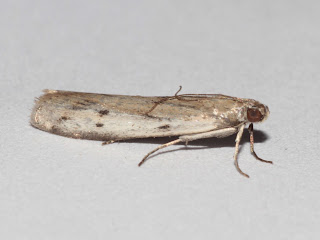Coniopteryx esbenpeterseni (male, gen det), North Elmham, 1st June - the first record for Norfolk!
Among the moths only a couple of species were new for the year: 2 Common Rush Case-bearers Coleophora alticolella and Barred Fruit-tree Tortrix Pandemis cerasana.
Common Rush Case-bearer Coleophora alticolella (male, gen det), North Elmham, 1st June
Barred Fruit-tree Tortrix Pandemis cerasana, North Elmham, 1st June
Other moths that night were 8 Buff Rush Case-bearers Coleophora caespititiella, Brown House Moth Hofmannophila pseudospretella, Hook-marked Straw Moth Agapeta hamana, 4 Common Marbles Celypha lacunana, Crescent Bell Epinotia bilunana, 2 Triple-blotched Bells Notocelia trimaculana, Hoary Bell Eucosma cana, Hook-streaked Grass-Veneer Crambus lathoniellus, 5 Common Greys Scoparia ambigualis, Small Magpie Anania hortulata, Chalk Knot-horn Phycitodes maritima, Maiden's Blush, Blood-vein, Treble Brown Spot, 2 Silver-ground Carpets, 2 Common Marbled Carpets, 4 Green Carpets, 2 Mottled Pugs, 9 Common Pugs, Clouded Border, Brimstone Moth, 2 Willow Beauties, Poplar Hawk-moth, Coxcomb Prominent, Pale Prominent, 7 White Ermines, 5 Buff Ermines, 3 Cinnabars, Heart and Dart, Shuttle-shaped Dart, Flame Shoulder, 2 Ingrailed Clays, Bright-line Brown-eye, Lychnis, Rustic Shoulder-knot, 3 Brown Rustics, Angle Shades, Clouded-bordered Brindle, 7 Treble Lines and 9 Straw Dots.
Chalk Knot-horn Phycitodes maritima, North Elmham, 1st June
Buff Ermine, North Elmham, 1st June
The Mayfly Lake Olive Cloeon simile was my first here this year.
Lake Olive Cloeon simile, North Elmham, 1st June
Caddisflies included Athripsodes aterrimus and Mystacides longicornis, the former being new for the year.
Athripsodes aterrimus, North Elmham, 1st June
This soldier beetle proved to be the reddish form of Cantharis rufa - the first time I've positively identified this species.
Cantharis rufa, North Elmham, 1st June
The bug Kleidocerys resedae was my first this year.
Kleidocerys resedae, North Elmham, 1st June











No comments:
Post a Comment